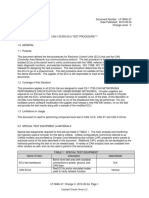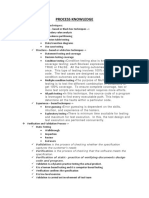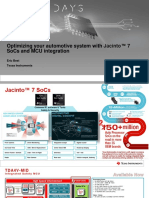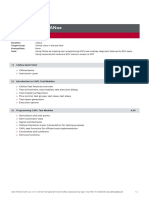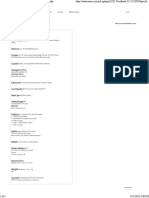0 ratings0% found this document useful (0 votes)
161 viewsDSPACE Hardware in the Loop (HiL) Testing
Understanding DSPACE HIL
Uploaded by
Jaya Teja ChintaCopyright
© © All Rights Reserved
Available Formats
Download as PDF, TXT or read online on Scribd
0 ratings0% found this document useful (0 votes)
161 viewsDSPACE Hardware in the Loop (HiL) Testing
Understanding DSPACE HIL
Uploaded by
Jaya Teja ChintaCopyright
© © All Rights Reserved
Available Formats
Download as PDF, TXT or read online on Scribd
You are on page 1/ 10
Tutorial on dSPACE
Hardware-in-the-Loop
(HiL) Testing
dSPACE HiL testing is a
powerful method used to
validate and verify
embedded control systems in
real-time before deploying
them in actual hardware.
dSPACE Hardware-in-the-Loop (HiL)
01. Introduction to dSPACE HiL Testing
HiL testing allows the simulation of a virtual environment
for embedded systems. It is used extensively in industries like
automotive, aerospace, and robotics to validate:
Control algorithms
System behaviors under various conditions
Fault scenarios
Advantages of HiL Testing:
Reduces development time and costs.
Detects bugs early in the development cycle.
Simulates complex, real-world scenarios safely.
02. Components of a dSPACE HiL Setup
A typical dSPACE HiL setup includes the following
components:
Real-Time Processor: Executes the simulation models in
real time.
I/O Modules: Interface with the device under test (DUT).
Failure Insertion Unit (FIU): Introduces faults into the
system.
ControlDesk: dSPACE’s user interface software for real-
time monitoring and control.
Model-in-the-Loop (MiL)/Software-in-the-Loop (SiL)
models**: Plant models created in MATLAB Simulink
or other tools.
Power Supplies and DUT: Provides input to the
hardware.
dSPACE Hardware-in-the-Loop (HiL)
03. Key Features of dSPACE Tools
Scalable platforms: Modular hardware for different
applications.
Customizable I/O: Analog, digital, CAN, LIN, and
FlexRay support.
Fault Injection: Simulates real-world failures in
controlled environments.
High integration: Seamless link with MATLAB Simulink.
04. Steps to Perform HiL Testing Using dSPACE
Step 1: Prepare the Plant Model
01. Design the Model:
Use MATLAB Simulink to create the plant model.
Include subsystems for sensors, actuators, and
environmental conditions.
02. Parameterize the Model:
Adjust model parameters to match real-world
conditions (e.g., vehicle dynamics, engine models).
03. Real-Time Constraints:
Ensure the model meets real-time simulation
requirements.
Step 2: Compile the Model
01. Code Generation:
Use Simulink Coder or dSPACE TargetLink to
generate real-time code from the Simulink model.
Verify that the model is compatible with the dSPACE
system.
02. Load into dSPACE:
Upload the generated code onto the dSPACE real-time
hardware.
dSPACE Hardware-in-the-Loop (HiL)
Step 3: Connect the Hardware
01. Setup the DUT:
Connect the Device Under Test (DUT) to the dSPACE
I/O interface.
02. Interface Configuration:
Configure analog, digital, and communication
interfaces (e.g., CAN, LIN, FlexRay).
Step 4: Use ControlDesk
01. Create a Layout:
Set up a user interface in dSPACE ControlDesk for
real-time monitoring and parameter tuning.
02. Monitor Real-Time Variables:
Observe system responses and adjust parameters as
needed.
03. Data Logging:
Use ControlDesk to log data for further analysis.
dSPACE Hardware-in-the-Loop (HiL)
Step 5: Perform Fault Injection
01. Use the FIU:
Simulate faults like sensor disconnections or short
circuits.
02. Monitor Responses:
Validate the system’s behavior under failure
conditions.
Step 6: Test Automation
01. AutomationDesk:
Use dSPACE AutomationDesk for automating test
sequences.
02. Test Cases:
Develop and execute multiple test scenarios, including
edge cases.
05. Common Applications of dSPACE HiL Testing
Powertrain Testing:
Simulate engines, transmissions, and electric drives.
ADAS and Autonomous Systems:
Test Advanced Driver-Assistance Systems (ADAS) like
lane-keeping and collision avoidance.
Battery Management Systems:
Validate battery behavior under varying loads.
Chassis and Suspension:
Analyze vehicle dynamics and control.
06. Advanced Features
XIL API Integration: Allows interaction with third-party
testing tools.
Multicore Support: Execute complex models using
parallel processing.
Scenario Simulation: Use pre-built or custom traffic
scenarios for ADAS testing.
Custom Scripts: Python or MATLAB scripts to
automate and analyze tests
07. Example: HiL Test for a Vehicle’s ABS System
Model Creation: Build a Simulink model for vehicle dynamics and
ABS logic.
Hardware Integration: Connect the ECU to the dSPACE HiL
simulator via CAN.
Scenario Testing: Simulate different road conditions (wet, dry,
icy).
Analyze Results: Log braking distance, wheel speed, and slip ratio
data.
08. Challenges in HiL Testing
Model Complexity: High-fidelity models require more
processing power.
Real-Time Constraints: Simulations must run without delays to
match physical systems.
Integration: Ensuring seamless communication between DUT
and HiL setup.
09. Tips for Beginners
Start Small: Begin with simple models and gradually increase
complexity.
Understand Tools: Familiarize yourself with MATLAB
Simulink and ControlDesk.
Use Documentation: Leverage dSPACE’s official guides and
online resources.
Was it Like
helpful? Comment
follow for more!
Share
Chetan Shidling
@chetan_shidling_ Save
www.cselectricalandelectronics.com
You might also like
- Automotive Embedded Testing Course ContentNo ratings yetAutomotive Embedded Testing Course Content10 pages
- Tejas - PJ - ADAS Test Engineer Resume - CAPLNo ratings yetTejas - PJ - ADAS Test Engineer Resume - CAPL3 pages
- Installation Guide and User Manual: Accessory Test System (ATS)No ratings yetInstallation Guide and User Manual: Accessory Test System (ATS)71 pages
- lp384d27 125&500 Componet Test ProcedureNo ratings yetlp384d27 125&500 Componet Test Procedure36 pages
- Automatic Simulation Measurement and Verification of Inputs and Outputs of Body Control ModuleNo ratings yetAutomatic Simulation Measurement and Verification of Inputs and Outputs of Body Control Module4 pages
- PLC: Programmable Logic Controller – Arktika.: EXPERIMENTAL PRODUCT BASED ON CPLD.From EverandPLC: Programmable Logic Controller – Arktika.: EXPERIMENTAL PRODUCT BASED ON CPLD.No ratings yet
- dSPACENews2006-3 AutomationDesk en Pn422No ratings yetdSPACENews2006-3 AutomationDesk en Pn4222 pages
- CAPL 3 CANNewsletter 201411 PressArticle enNo ratings yetCAPL 3 CANNewsletter 201411 PressArticle en2 pages
- 4-14 - p18 - Tips-And-Tricks-For-The-Use-Of-Capl-Part 3 - Lobmeyer - MarktlNo ratings yet4-14 - p18 - Tips-And-Tricks-For-The-Use-Of-Capl-Part 3 - Lobmeyer - Marktl4 pages
- Automated Driving With Matlab and SimulinkNo ratings yetAutomated Driving With Matlab and Simulink51 pages
- A Modular System Architecture For Sensor Data Processing of ADAS Applications100% (1)A Modular System Architecture For Sensor Data Processing of ADAS Applications6 pages
- HIL Powertrain Simulation and Testing: An Automotive Industry StandardNo ratings yetHIL Powertrain Simulation and Testing: An Automotive Industry Standard14 pages
- Canking - Can Simulation Software: EX. NO.1.B 02-07-2019No ratings yetCanking - Can Simulation Software: EX. NO.1.B 02-07-20196 pages
- AUTOSAR PRS SOMEIPServiceDiscoveryProtocolNo ratings yetAUTOSAR PRS SOMEIPServiceDiscoveryProtocol74 pages
- Process Knowledge: Test Case Design TechniquesNo ratings yetProcess Knowledge: Test Case Design Techniques2 pages
- Optimizing Your Automotive System With Jacinto™ 7 Socs and Mcu IntegrationNo ratings yetOptimizing Your Automotive System With Jacinto™ 7 Socs and Mcu Integration18 pages
- Getting Started With PSoC Creator IDE and FreeSoC2 (PSoC 5LP)No ratings yetGetting Started With PSoC Creator IDE and FreeSoC2 (PSoC 5LP)8 pages
- An Overview of Automotive Service-OrientedNo ratings yetAn Overview of Automotive Service-Oriented19 pages
- Mastering Rtos: Hands On Freertos and Stm32Fx With DebuggingNo ratings yetMastering Rtos: Hands On Freertos and Stm32Fx With Debugging348 pages
- Introduction To Popcornsar Adaptive Autosar (R20-11) Tool ChainNo ratings yetIntroduction To Popcornsar Adaptive Autosar (R20-11) Tool Chain27 pages
- Development of Hardware-In-The-loop Simulation System For ElectriNo ratings yetDevelopment of Hardware-In-The-loop Simulation System For Electri83 pages
- What Is ADAS ?: Synopsis/Survey Vinod Raj J DSU15MES017No ratings yetWhat Is ADAS ?: Synopsis/Survey Vinod Raj J DSU15MES0174 pages
- Real-Time Operating Systems: Part 1: Mars Pathfinder 1997No ratings yetReal-Time Operating Systems: Part 1: Mars Pathfinder 1997159 pages
- FlexRay and its Applications: Real Time Multiplexed NetworkFrom EverandFlexRay and its Applications: Real Time Multiplexed NetworkNo ratings yet
- KIM - Kotak Transportation & Logistics FundNo ratings yetKIM - Kotak Transportation & Logistics Fund19 pages
- CAPL (CAN Access Programming Language) code examplesNo ratings yetCAPL (CAN Access Programming Language) code examples10 pages
- Electric and Electronic Rotary Gear Motor Series AB1 AB1... E Istruzioni 2No ratings yetElectric and Electronic Rotary Gear Motor Series AB1 AB1... E Istruzioni 212 pages
- 1MRS756253 - MS X - Network Control - Web PDFNo ratings yet1MRS756253 - MS X - Network Control - Web PDF10 pages
- Intrusion Detection Systems: ANN For Misuse DetectionNo ratings yetIntrusion Detection Systems: ANN For Misuse Detection25 pages
- Draft Filsfils Spring srv6 Network Programming 07No ratings yetDraft Filsfils Spring srv6 Network Programming 0742 pages
- Activating X Entry XDOS OPEN SHELL 9.2020No ratings yetActivating X Entry XDOS OPEN SHELL 9.202012 pages
- Designing A Website Using Website BuilderNo ratings yetDesigning A Website Using Website Builder32 pages
- Digital Micro-Ohmmeter: - Test Current Set FromNo ratings yetDigital Micro-Ohmmeter: - Test Current Set From1 page
- Installation Guide and User Manual: Accessory Test System (ATS)Installation Guide and User Manual: Accessory Test System (ATS)
- Automatic Simulation Measurement and Verification of Inputs and Outputs of Body Control ModuleAutomatic Simulation Measurement and Verification of Inputs and Outputs of Body Control Module
- PLC: Programmable Logic Controller – Arktika.: EXPERIMENTAL PRODUCT BASED ON CPLD.From EverandPLC: Programmable Logic Controller – Arktika.: EXPERIMENTAL PRODUCT BASED ON CPLD.
- 4-14 - p18 - Tips-And-Tricks-For-The-Use-Of-Capl-Part 3 - Lobmeyer - Marktl4-14 - p18 - Tips-And-Tricks-For-The-Use-Of-Capl-Part 3 - Lobmeyer - Marktl
- A Modular System Architecture For Sensor Data Processing of ADAS ApplicationsA Modular System Architecture For Sensor Data Processing of ADAS Applications
- HIL Powertrain Simulation and Testing: An Automotive Industry StandardHIL Powertrain Simulation and Testing: An Automotive Industry Standard
- Canking - Can Simulation Software: EX. NO.1.B 02-07-2019Canking - Can Simulation Software: EX. NO.1.B 02-07-2019
- Optimizing Your Automotive System With Jacinto™ 7 Socs and Mcu IntegrationOptimizing Your Automotive System With Jacinto™ 7 Socs and Mcu Integration
- Getting Started With PSoC Creator IDE and FreeSoC2 (PSoC 5LP)Getting Started With PSoC Creator IDE and FreeSoC2 (PSoC 5LP)
- Mastering Rtos: Hands On Freertos and Stm32Fx With DebuggingMastering Rtos: Hands On Freertos and Stm32Fx With Debugging
- Introduction To Popcornsar Adaptive Autosar (R20-11) Tool ChainIntroduction To Popcornsar Adaptive Autosar (R20-11) Tool Chain
- Development of Hardware-In-The-loop Simulation System For ElectriDevelopment of Hardware-In-The-loop Simulation System For Electri
- What Is ADAS ?: Synopsis/Survey Vinod Raj J DSU15MES017What Is ADAS ?: Synopsis/Survey Vinod Raj J DSU15MES017
- Real-Time Operating Systems: Part 1: Mars Pathfinder 1997Real-Time Operating Systems: Part 1: Mars Pathfinder 1997
- FlexRay and its Applications: Real Time Multiplexed NetworkFrom EverandFlexRay and its Applications: Real Time Multiplexed Network
- CAPL (CAN Access Programming Language) code examplesCAPL (CAN Access Programming Language) code examples
- Electric and Electronic Rotary Gear Motor Series AB1 AB1... E Istruzioni 2Electric and Electronic Rotary Gear Motor Series AB1 AB1... E Istruzioni 2
- Intrusion Detection Systems: ANN For Misuse DetectionIntrusion Detection Systems: ANN For Misuse Detection






